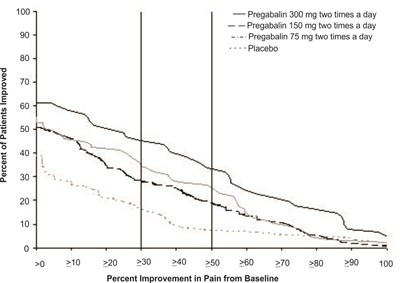Product Images Pregabalin
View Photos of Packaging, Labels & Appearance
- Label Image - lbl500906504
- equation - pregabain gault equation
- fig-01 - pregabalin figure 01
- fig-02 - pregabalin figure 02
- fig-03 - pregabalin figure 03
- fig-04 - pregabalin figure 04
- fig-05 - pregabalin figure 05
- fig-06 - pregabalin figure 06
- fig-07 - pregabalin figure 07
- fig-09 - pregabalin figure 09
- fig-10 - pregabalin figure 10
- fig-11 - pregabalin figure 11
- fig-12 - pregabalin figure 12
- str - pregabalin structure
Product Label Images
The following 14 images provide visual information about the product associated with Pregabalin NDC 50090-6504 by A-s Medication Solutions, such as packaging, labeling, and the appearance of the drug itself. This resource could be helpful for medical professionals, pharmacists, and patients seeking to verify medication information and ensure they have the correct product.
fig-01 - pregabalin figure 01

This text provides the percentage of patients improved with the use of Pregabalin in three different dosages and a placebo. It also includes the percentage improvement in pain from baseline.*
fig-02 - pregabalin figure 02

This appears to be a graph or chart showing the percentage of patients who have improved after taking Pregabalin 100 mg three times a day versus a placebo. The graph also shows the recorded percentage improvement in pain from baseline.*
fig-03 - pregabalin figure 03

This is a chart showing the percentage of patients who improved with different doses of Pregabalin and a placebo, based on their pain levels from a baseline.*
fig-04 - pregabalin figure 04

This is a chart showing the percentage of patients who improved after taking Pregabalin at different doses (100mg and 200mg three times a day) and a placebo. The chart also shows the percentage improvement in pain from the baseline, ranging from 10% to 100%.*
fig-05 - pregabalin figure 05

The given text describes a chart showing the percentage of patients who improved with different doses of Pregabalin and Placebo. It also shows the percentage improvement in pain from baseline for each treatment.*
fig-06 - pregabalin figure 06

This document appears to be a statistical data table showing responder rates for different treatment regimens in two different studies (E1 and E3), with different dosages (50mg/day, 150mg/day, 300mg/day, and 600mg/day) for a medication, with "BID" and "TID" indicating frequency of treatment administration, and "Placebo" indicating a control group. The responder rate ranges from 9% to 60%, and there are statistically significant results indicated by an asterisk (*) when compared to placebo.*
fig-09 - pregabalin figure 09

This is a graph showing the percentage of patients who experienced an improvement in pain from the baseline after taking different daily doses of pregabalin and a placebo. The x-axis shows the percentage of improvement in pain and the y-axis shows the percentage of patients who experienced that level of improvement. The graph shows that higher doses of pregabalin resulted in a greater percentage of patients experiencing an improvement in pain compared to a placebo.*
fig-11 - pregabalin figure 11

The text describes a graph showing the percentage of subjects who have improved from baseline to week 12 in a study using Pregabalin compared to Placebo. It shows the percentage of improvement from 0 to 100, with intervals of 10, on the x-axis, while the y-axis represents the percentage of patients improved. The graph shows that Pregabalin improves outcomes in more patients compared to placebo.*
* The product label images have been analyzed using a combination of traditional computing and machine learning techniques. It should be noted that the descriptions provided may not be entirely accurate as they are experimental in nature. Use the information in this page at your own discretion and risk.




